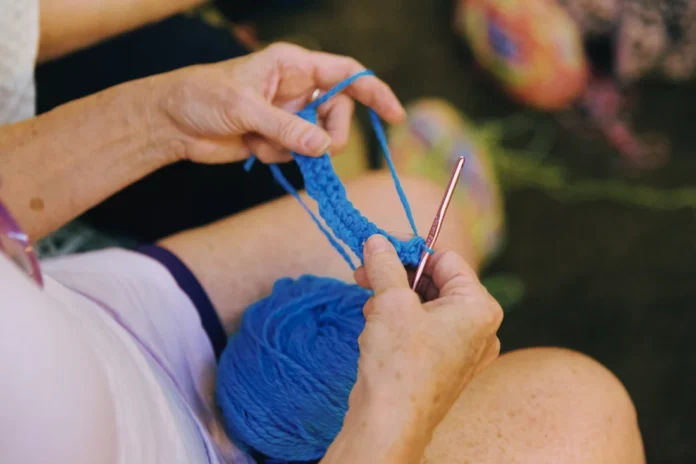“‘A big thing with grief is moving through it both mentally and physically,’ Gatto says. ‘And that’s exactly what we do here. We bring something that is maybe heavy on our minds or our hearts. And then we work with our hands. We work with it, and we work together'” (Balaban, 2024).
The practice of communal art can bring people together over a shared place, time, or feeling. In the case of this article, creators are brought together by one shared emotion – grief. Death and grieving of a departed loved one are universal experiences that transcend age, class, race, and so many other identifiers. However, these emotions often go undiscussed in our daily lives.
Gabrielle Gato noticed this when her father was given a fatal ALS diagnosis. “When he told me about his diagnosis, I knew two things right away: I wanted to spend as much time with him as possible and if I was going to be living in my childhood home, I would need a hobby.
Enter: the granny square.
I’m not very crafty, but I do like textiles. My mom knits, but in her youth, she’d crocheted a granny square blanket and was game to re-learn how to do it. Meanwhile, my dad — who has a funny sense of humor — decided his coping mechanism would be binge-watching ‘Grey’s Anatomy.’ Granny squares and Grey’s became the after dinner routine and soon I was churning out dozens of multicolored squares. And it felt like this project was, maybe, helping?” (Balaban, 2024)
Gato took this feeling and established the Weaving and Grieving group, which meets at Brooklyn’s Green-Wood Cemetery in New York City, New York.

Over the past year the group has grown, with members including those that have lost parents and even divorcees. Together, these people come together to move grief through the body “‘both mentally and physically’” (Balaban, 2024). The act of making has allowed members to relive memories of their loved ones, create with supplies they had been collecting, and pass their story along to other individuals. As time passed, the group grew outside the knitting and fiber community, encouraging members to bring any crafting project they wanted to work on. If people don’t want to bring their own supplies, there’s boxes of donated supplies lining the pews inside the chapel.

“One thing to note — even though the series is called “Grieving & Weaving,“ you don’t have to be doing either to participate. Mary Pat Klein, who co-facilitates the event along with Gatto, says they’re just trying to create community” (Balaban, 2024).
References
Balaban, S. (2024). A death educator and a knitter walk into a cemetery — it’s “Grieving & Weaving.” NPR. https://www.npr.org/2024/08/16/nx-s1-5053167/grieving-and-weaving-green-wood-cemetery-brooklyn
Cao, M. (2024). At “Grieving & Weaving,” any craft goes. Some people play with clay, embroider, quilt, draw with markers, and write on sticky notes [Photograph]. NPR. https://npr.brightspotcdn.com/dims3/default/strip/false/crop/3000×2000+0+0/resize/1600/quality/85/format/webp/?url=http%3A%2F%2Fnpr-brightspot.s3.amazonaws.com%2F32%2F27%2F788b252240f99b11021315578d1a%2F20240723-weavinggrief-mengwencao-050.jpg
Cao, M. (2024). Gabrielle R. Gatto, coordinator of public programs at The Green-Wood Cemetery [Photograph]. NPR. https://npr.brightspotcdn.com/dims3/default/strip/false/crop/3000×2000+0+0/resize/1600/quality/85/format/webp/?url=http%3A%2F%2Fnpr-brightspot.s3.amazonaws.com%2Fbc%2F44%2Fd2b4650745379d5292f16d772a79%2F20240723-weavinggrief-mengwencao-023.jpg




